SINGAPORE – It is the season for feasting and Chinese food is perfect for the occasion. While design is not usually a priority when it comes to Chinese cuisine, these restaurants show that even the best food can be elevated with the right atmosphere.
Here are five restaurants – some new, and one that dates back to the 1980s, though recently revamped – that count decor as an important ingredient for a complete Chinese New Year dining experience.
1. Yue Bai – 33 Duxton Road
Chef Lee Hongwei has a poetic vision for his new Chinese restaurant Yue Bai.
While reading Tang Dynasty poet Bai Juyi’s Ballad Of The Lute, about Bai’s encounter with a pipa (Chinese lute) player in the moonlight, the chef decided that the restaurant interiors should evoke a similar dreamy atmosphere.
“I want to give guests the experience of meandering through the streets in the moonlight,” he says.
Lee, 43, has been in the food and beverage industry for more than 20 years. Around a decade ago, he developed an interest in shi liao, or Chinese dietary therapy, as well as yao shan, or Chinese medicinal food.
In 2014, he worked at Chinese restaurant Hao Yun Lai under executive chef N.K. Chai, who is known for his Chinese dietary therapy cuisine.
With Yue Bai, which opened in December 2022, Lee presents a Southern Chinese menu based on principles such as using ingredients and preparation to create dishes that complement the body’s constitution and also the season.
For his food, the interiors had to be “simple and elegant”, he says.
He also wanted to be located in Duxton Hill, with its low-rise shophouses and narrow streets.
“I always wanted to have my restaurant in an old shophouse, and there is something very attractive about this neighbourhood,” he says.

Enter the restaurant, and there is a small reception area and then a narrow corridor, which alludes to the narrow streets outside. A row of four dining booths lines one side of this internal “street”.
The restaurant was designed by Ms Tan Hui Ee, director of interior design firm Two by Four. She says the layout was inspired by traditional Chinese gardens, with their meandering paths and framed views.
The 1,950 sq ft restaurant has a seating capacity of 42 and occupies the ground floor of two shophouses divided into zones.
The zone with the booths is designed to suggest a street lined with traditional Chinese tea houses or pavilions. Timber trellises and screens used to partition the booths add to the effect.
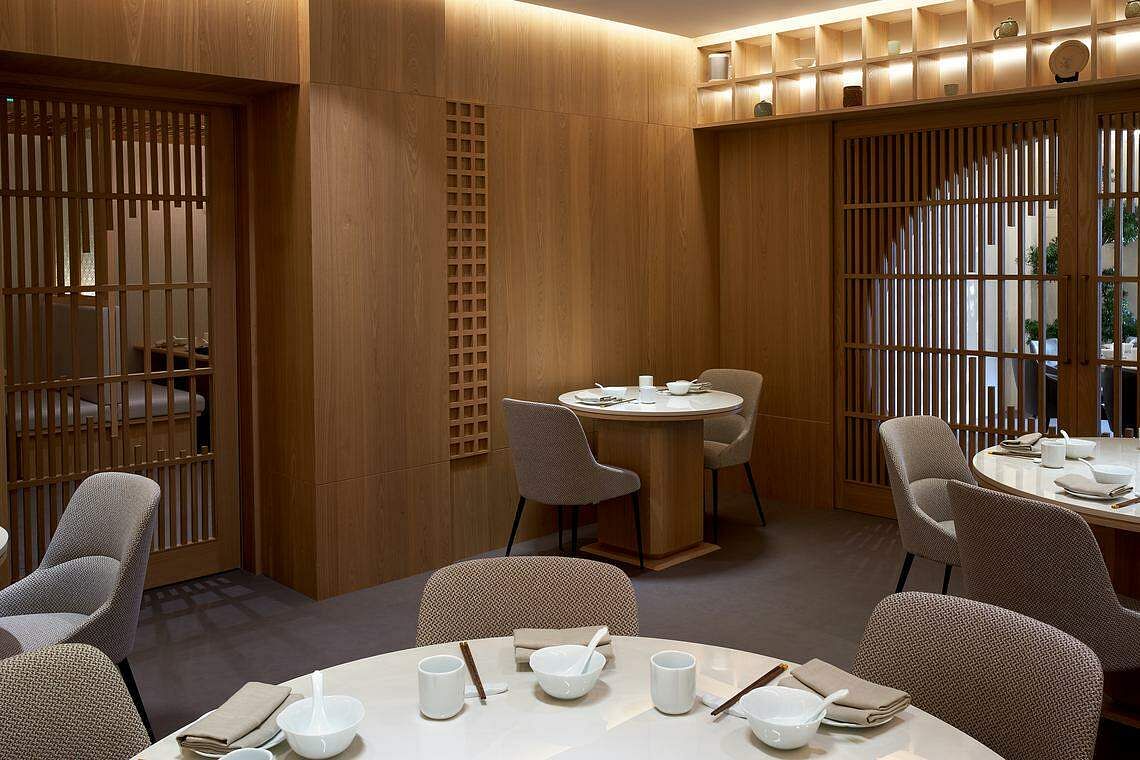
The corridor or internal street leads to a sliding timber screen with a circular motif – a reference to moon gates in Chinese gardens – that opens into an inner dining hall.
This zone has been simply decorated with ceramic artworks and laser-cut text from Huang Di Nei Jing, or the Yellow Emperor’s Classic Of Medicine.
On one wall is a circular faux window to suggest a view of a bigger garden beyond. On the opposite wall is another sliding timber screen that opens to reveal an actual moon gate, which frames the entrances to a more exclusive zone – the private dining room.
“Chinese restaurants are usually too ornate,” says Ms Tan.
The material used for the fittings and finishes is largely either solid oak or oak veneer, all stained the same neutral tone.
“We wanted to limit the material palette to wood and show how it could be used in different ways. This was also inspired by chef Lee’s cuisine, which is about elevating the ingredients he uses,” adds Ms Tan.

Yue Bai will be serving its Chinese New Year menu from Jan 30. It will include the chef’s signature dishes such as Herbal Poached Rice with Atlantic Cod, Black Fungus and Angelica Wine ($38). This is served in a hot stone pot and finished tableside with fish broth and herbal Shaoxing wine.
It is a refined menu, presented in a refined Chinese setting.
To elevate the experience, Yue Bai has a dress code – smart casual wear is required and “strictly no flip flops” are allowed. But Lee says it has been difficult to impose this in Singapore, where shorts and T-shirts are the norm.
“I do try,” he adds.
2. Synthesis – 01-643 Suntec City East Wing Tower 4, 3 Temasek Boulevard
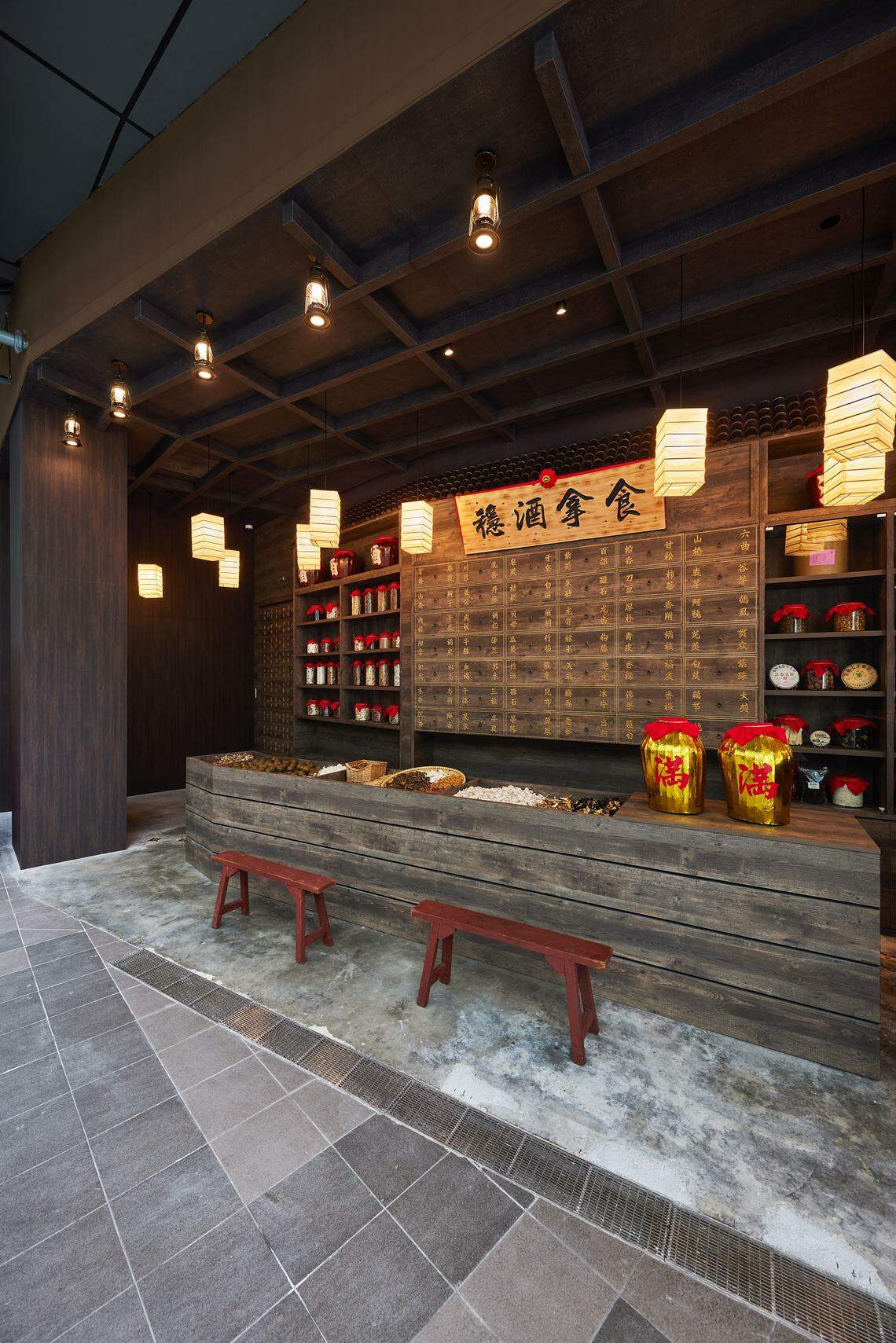
To target working adults aged 30 and above, Mr Sebastian Ang, co-founder of Chinese restaurant and bar Synthesis, says he wanted to create a venue with a “wow factor”. And he did this by mixing nostalgia with dance music.
From the outside, Synthesis, which opened in March 2023, looks like a traditional Chinese medicine (TCM) shop, with herbs on display and even a wall feature that resembles the old cabinetry typically seen in such shops, with small drawers used for storage.
Mr Ang, 33, gets nostalgic for Chinese herbs. “My grandmother used to work at a TCM hall near Kallang, so I grew up with the smell of Chinese herbs. These herbs were also infused into all our meals,” he says.
The TCM area at Synthesis is the waiting area for restaurant patrons. “I wanted people to be able to smell the herbs before they go in,” says Mr Ang.
The menu, which he co-created with TCM consultants, has a wellness theme and is “embedded” with Chinese herbs, he adds.
The average spending of customers is $50 to $60 a head for dishes such as Sakura Chicken Herbal Poached Rice ($24) and Yam Abacus Seed Truffle Carbonara ($30).
He designed Synthesis despite having no formal training in interior design. His approach was inspired by his personal experiences and childhood memories.
“I worked out how many tables I needed, then I decided on the different zones,” he says.
Mr Ang is also the designer and co-owner of the speakeasy bar Mama Diam and the cafe and cocktail bar Lou Shang, which are both in Prinsep Street and have nostalgia-themed design elements as well.
“I think I know what my customers want,” he says.
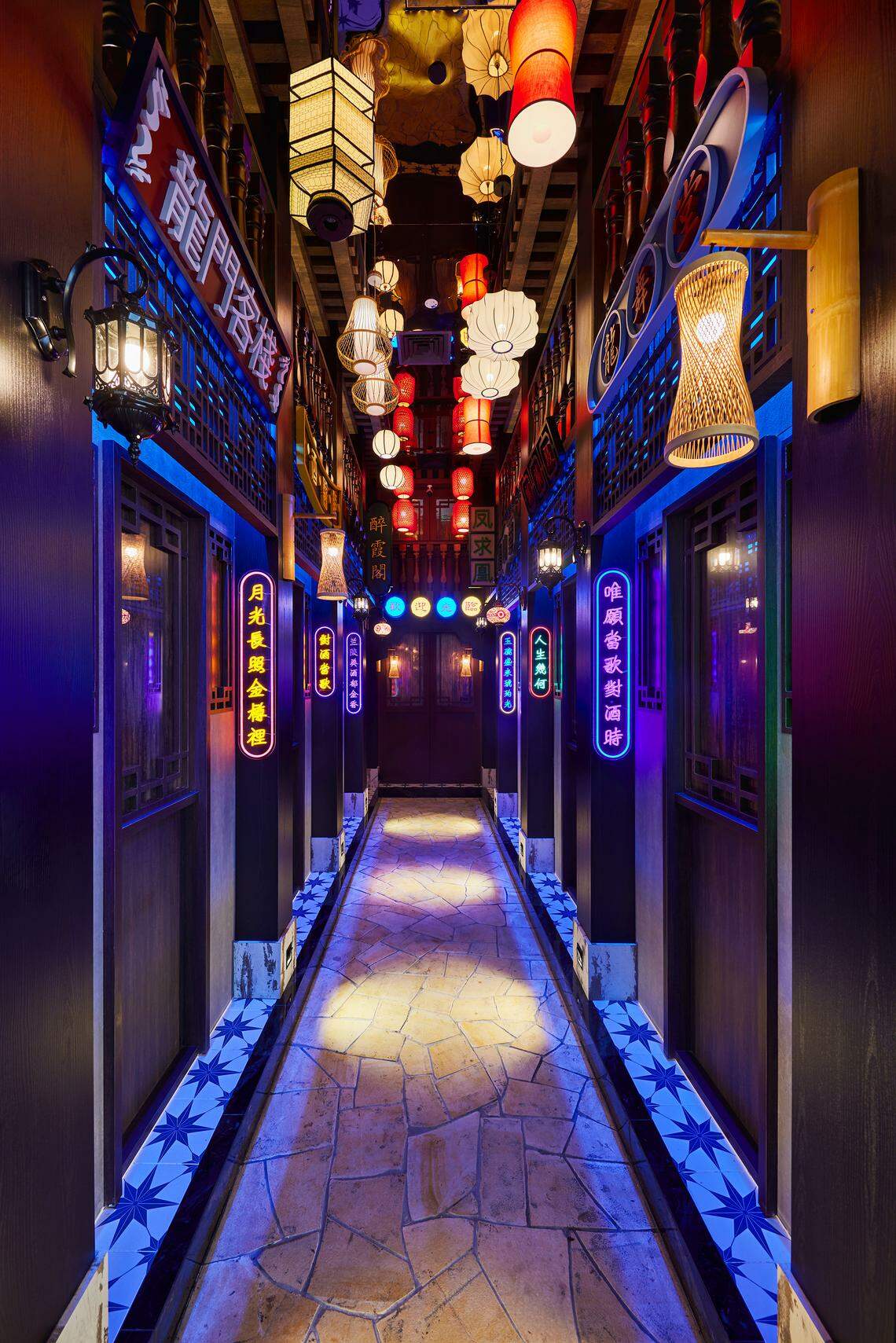
The floor area for the 120-seater Synthesis is about 5,000 sq ft, so he had space to play with.
From the TCM waiting area, diners pass a narrow corridor designed to look like an old alley in a Chinese town. Faux shopfronts line both sides of the pathway.
The alley heightens the sense of anticipation before guests enter via a door, disguised as another shopfront, into a foyer with ornate timber screens. This leads to the bar.
The bar delivers further drama with its high vaulted ceiling, clad in metal sheeting with an embossed ripple effect. Spirits are displayed in a rack that follows the curve of the ceiling, with bottles looking like they are about to fall out.
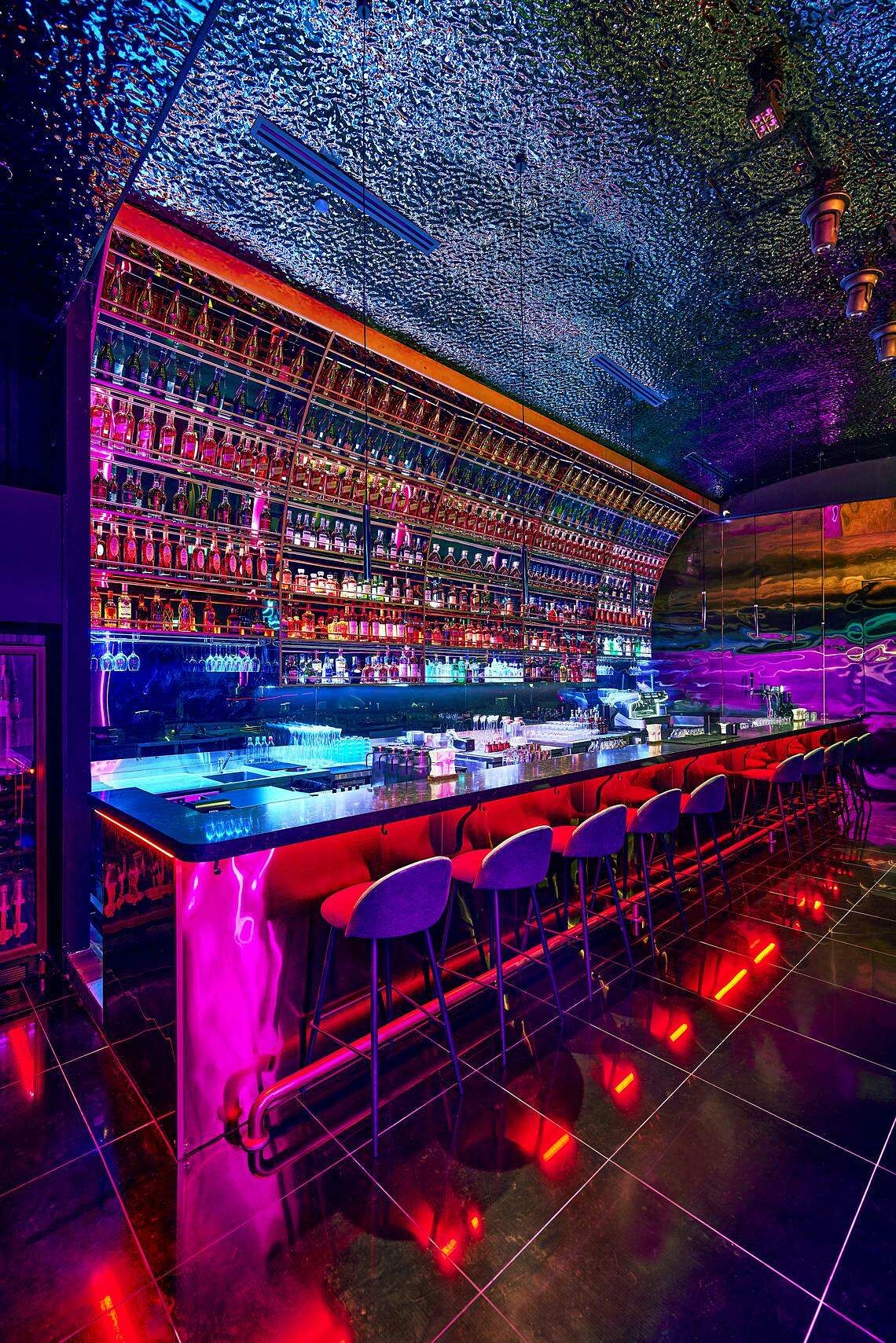
The metal cladding with the ripple effect is there to evoke water, one of the five elements in TCM – water, fire, metal, earth and wood – that are represented in the design of Synthesis.
In the main dining area, Mr Ang designed LED lightboxes that are programmed to simulate a wave of fire. Warped metal sheeting in gold, representing the element of metal, clads the far wall of the dining area.
Timber logs, bark and all, were used to create a wall feature that represents the element of wood. Marble tabletops, including the communal table in the middle of the space, represent earth.
These materials, combined with piped-in dance music and mood lighting, give Synthesis a party atmosphere. In fact, after the last dinner plates are cleared, the venue turns into a lounge bar.

Chinese food and a lounge bar are an unusual combination, but Synthesis is a very personal project for Mr Ang.
“It’s based on my experience when I was young, and the only way to make something genuine and not gimmicky is to be as real as possible,” he says.
3. Cherry Garden – Mandarin Oriental Singapore, 5 Raffles Avenue
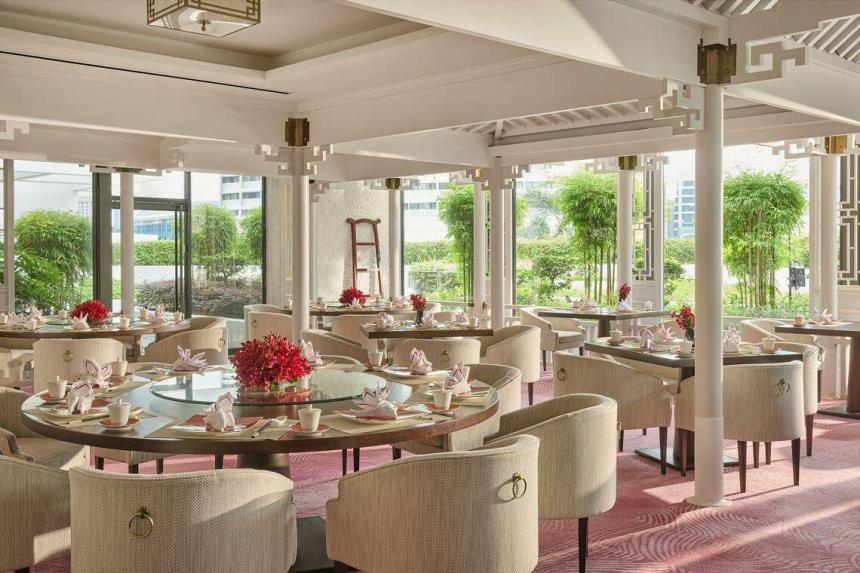
Cherry Garden has been around for a while, having opened in 1987 at the Mandarin Oriental Singapore hotel.
While the restaurant has gone through minor refurbishments over the years, it has always had dark, decorative woodwork inspired by Chinese architecture.
In 2023, the hotel underwent a six-month renovation and was injected with brighter colours by the design firm DesignWilkes, which had been tasked to refresh the restaurant’s look.
Mr Marcel Li, who is in his 40s, and director of food and beverage at the hotel, says the restaurant’s interiors were brightened with contemporary touches and new artwork in line with the transformation of the rest of the hotel.
But the existing Chinese architectural elements and antique doors at the entrance had to remain.
DesignWilkes’ principal designer Jeffrey Wilkes says his first impression of Cherry Garden was that “it felt a little dated and dark in terms of the ambience”.

“As we were lightening the rest of the hotel and injecting a modern tropical sense, we decided to bring that aesthetic into the restaurant,” says Mr Wilkes, who is in his early 60s and based in Kuala Lumpur, Malaysia.
His main design strategy was to paint the Chinese timber elements white. “This has the biggest impact on the space, giving its original dark environment a lightened and more contemporary touch with the low-lustre creamy white paint on all trellis and timber elements,” he says.
The original carpeting, with its cherry tree motif, was replaced by a pink carpet with a simple wavy pattern to complement linen-covered dining tub chairs.
The cherry tree motif is used in a series of photo murals that now hang on the previously unadorned walls.
“A new credenza, a few mid-century modern lamps and a collection of graphically composed photo collections complete the picture,” says Mr Wilkes.
The restaurant spans 3,722 sq ft excluding the kitchen, and can seat 84 guests.
White is not a colour usually associated with Chinese restaurant interiors. However, the Chinese-style trellises and details on the faux roof structure – now all in white – prove that Cherry Garden is still a Chinese restaurant, albeit a contemporary one.

Mr Li says the menu of Cantonese cuisine has also been updated with new signature dishes such as braised pork ribs in bamboo string wrap ($40) and XO fried rice with minced wagyu beef ($40), all presented with “artistic modern flair”.
Now, there are interiors to match.
4. The Chairman’s Lounge – Level 3, Pan Pacific Orchard Singapore

Chinese food is an affair of the arts at The Chairman’s Lounge at the Pan Pacific Orchard Singapore.
While the interior of the private dining space is elegantly understated, what defines it is a 20-panel calligraphy artwork by the late Chua Ek Kay (1947 to 2008), Cultural Medallion recipient and one of Singapore’s most renowned artists.
The artwork is owned by Pan Pacific Hotels Group (PPHG), a member of the Singapore-listed UOL Group.
Mr Dalip Singh, the hotel’s general manager, says the artwork is “a significant cultural asset” and potentially the largest single piece of calligraphy by the late artist.
Titled A Collection Of Tang Poetry By Li Bai, Enjoying Wine And Conversation With Scholar Friends, the artwork was commissioned for the Grand Plaza Parkroyal Hotel and completed in 1992. The hotel in Kitchener Road was sold by PPHG in 2023.
The artwork encapsulates 17 poems unified by the themes of feasting and drinking, and lends “artistic depth and poetic elegance” to the dining experience, says Mr Singh, adding that The Chairman’s Lounge was designed and conceptualised with the piece in mind.
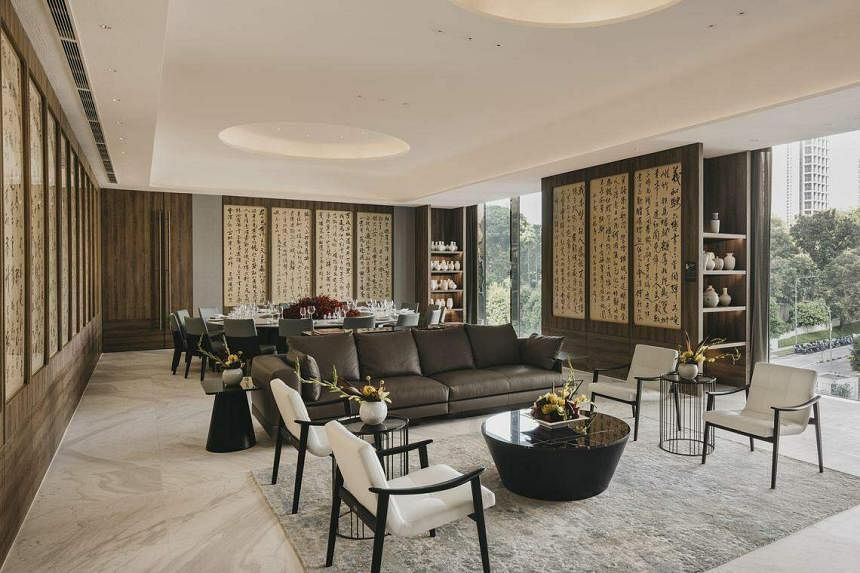
The 52-year-old says the 1,098 sq ft space was envisaged as a spacious family living and dining room.
The private dining room is located on Level Three of the 347-room hotel, which opened in 2023. There is only one dining table – albeit a very large custom-designed one that can seat up to 16 customers.
The space was designed by architectural firm Woha, also the architects for the hotel.
The interior of the private dining space was expressed as an art gallery with a simple, modern palette, to pay homage to the artwork, says Mr Phua Hong Wei, 44, a director with Woha.
He adds: “The artwork commands attention and is a conversation starter.”
The Chairman’s Lounge is finished in timber wall panelling. Openings in the panelling frame the calligraphy within.
Accents like the leather-finish white marble floor are kept simple and elegant to focus guests’ attention on the surrounding artwork, activities and food.
There is a finishing kitchen located next door to assemble and portion the food before it is served. The menu is created by Chinese master chef Leung Wing Cheung and prepared in the hotel’s banquet kitchen.
Set menus for 10 people are priced from $2,688++ (plus service charge and GST) to $3,288++ for an eight-course menu. Signature dishes include the Prosperity Exotic Garden Yusheng, which features lobster, and the Pan-Seared Dried Oyster With Duet Of Traditional Crispy Chicken, with foie gras.

Leung, 62, moved to Singapore from Hong Kong about 30 years ago. He is considered to be among the first wave of Hong Kong chefs to have impacted the local culinary scene.
In a press statement, he says: “My aim is to craft dishes that not only entice the senses but also weave a narrative, connecting diners to the rich legacy of Chinese culinary tradition.”
He adds that he is a staunch advocate of the Chinese maxim “se xiang wei ju quan”, which translates as “food that excels in colour, aroma and taste”.
The maxim also resonates with the musings of Li Bai, especially for those who care to read Chua’s monumental rendition as they dine.
5. Coincidence – 10 North Canal Road
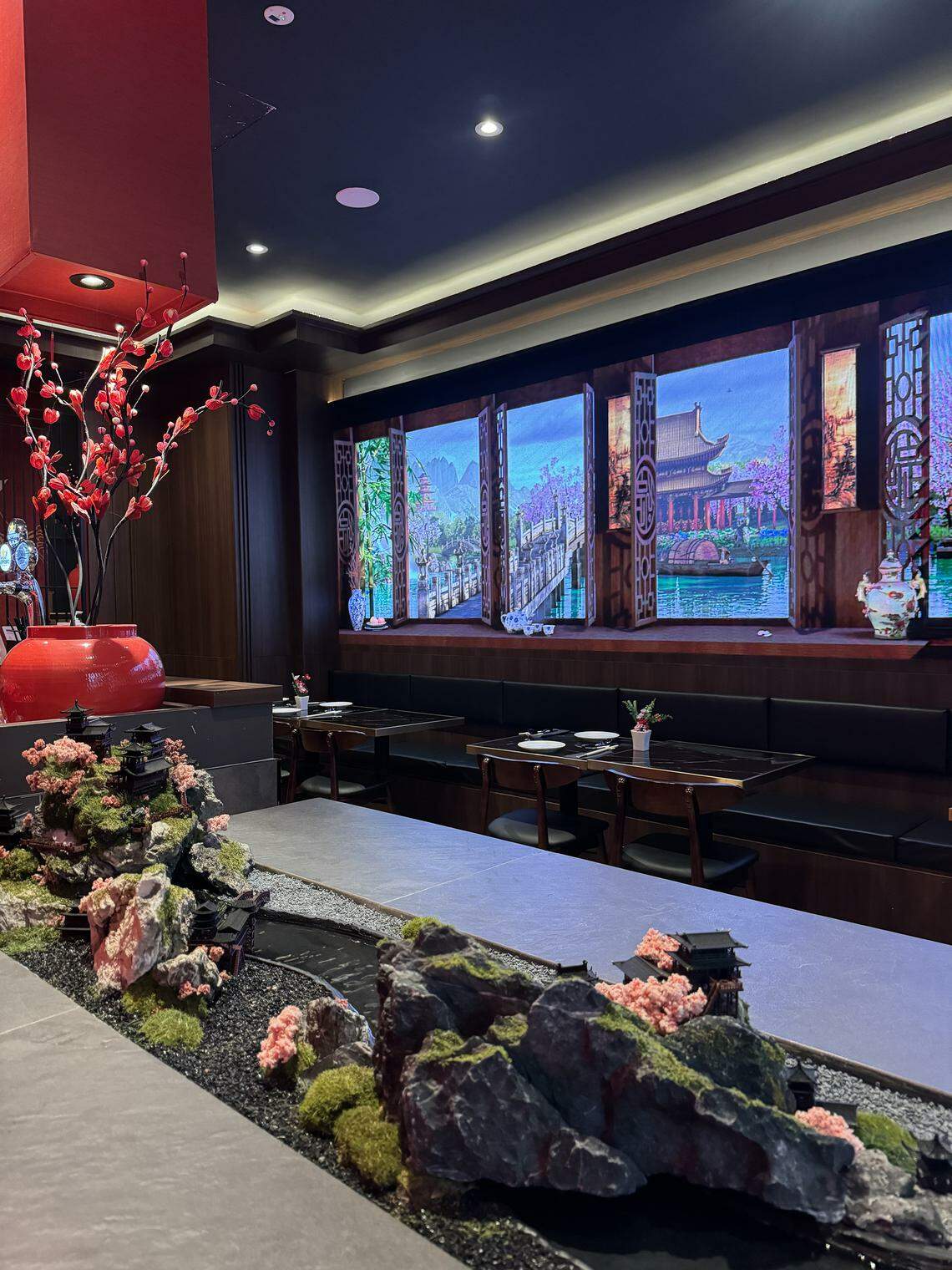
In the heart of Singapore’s Central Business District is Coincidence, a restaurant and bar serving Chinese cuisine in a setting that appears old and new at the same time.
Its co-founder, Mr Joseph Neo, says the intent behind the design was to “break away from the formalities associated with traditional fine-dining establishments”.
Describing the ambience as “cheeky and inviting”, the 36-year-old adds: “We wanted the design to transcend traditional boundaries, allowing for the creation of different thematic settings.”
The 2,300 sq ft restaurant and bar opened in August 2023 and occupies two levels of a shophouse in North Canal Road. There is a lounge on Level Three and private event spaces on Level Four.
Here, traditional design elements are presented in a different way. Two LED screens dominate the restaurant and bar. They play videos of digital illustrations of traditional Chinese architecture set in picturesque landscapes, and these change with the time of day.
Measuring 21 ft (6.5m) by 23 ft in length, the panels create an immersive effect for the customers.
There is also a feature table on Level One for communal dining, which incorporates a custom-made miniature display of a Chinese landscape – complete with a running stream, pagodas and other buildings – by local designers The Mossiah.
The combination of the video projection and miniature landscape creates a surreal atmosphere.
“The goal was to offer our customers a unique and evolving dining ambience, ensuring that each visit to our establishment would be a fresh and memorable experience,” says Mr Neo, who is also a director in the banking and finance industry.

Coincidence was designed by local firm Hall Interiors.
Mr Tiong Ing Hou, 37, the firm’s co-founder, says the design “incorporates elements that specifically resonate with Chinese culture”. This was done to set it apart from the more minimalist Japanese aesthetic, he adds.

Red was used to highlight areas such as the display cabinets at the bar. “Traditionally, red symbolises prosperity, good fortune and joy in Chinese culture,” adds Mr Tiong.
The cuisine is unmistakably Chinese. Helming the kitchen is chef Raymond Sui, who has created dishes such as Divine Crispy Prawn Roll topped with birds’ nest and ikura, and drizzled with honey chrysanthemum sauce ($22.80).
Another popular dish is Foursome, made with egg white scallop, sharks’ fin, birds’ nest and caviar, and topped with gold flakes ($28.80).
Mr Neo describes the cuisine as modern Chinese fusion that merges traditional flavours with global influences to give “a contemporary twist on classic Chinese cuisine”.
And the design of Coincidence, too, is a contemporary twist on the Chinese restaurant.


